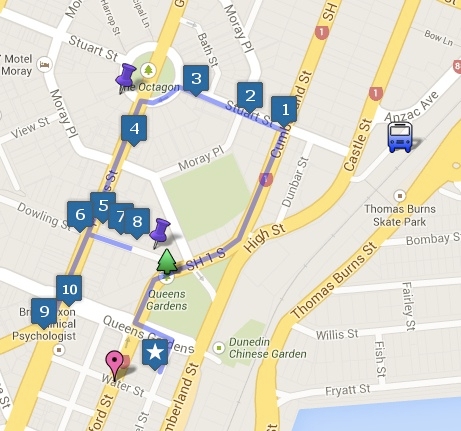Tracey M Benson
Walks of absent memory combines a local walk around the city on Dunedin with the use of augmented reality. This work has been created by Australian based media artist Tracey Benson to explore the site of Dunedin as a potential tourist, seeking to build a knowledge of the location from afar – past and present events, spaces, places and histories.
The work is a literal walk around a central area of Dunedin, where participants can discover some ghostly relics of buildings. This is achieved by downloading and using an app for Internet enabled hand-held devices (smartphones and tablets) in conjunction with an online (http://geokult.com/2013/09/09/walks-of-absent-memory-mesh-cities-dunedin/) and printed guide to the walk. The accompanying guide is designed to assist the audience (tourist) to explore the city through the eyes of an absent stranger – to recreate a fictional memory lost in time.
Like so many other contemporary travelers, much time and energy is invested into learning about a place when planning a visit. Where to go, what to see, what is the history and heritage are familiar things people wish to know before arriving at the destination. However, in the case of Walks of absent memory the artist/tourist does not reach the destination, rather a number of augmented remnants in the city act as a proxy for the journey.
The source material for Walks of absent memory was acquired via a range of popular online channels – Google Maps and Streetview, Wikipedia and other online sources. The process of gathering this ‘online intelligence’ informs the design of the walk, particularly by locating heritage images and sites of Dunedin’s past.
This map shows the key landmarks identified in Dunedin for Walks of absent memory. The numbered icons refer to the ‘stops’ in the walk, starting with point ‘0’.
Walks of absent memory is designed to play with the themes outlined in MESH Cities – particularly the notion of a networked city and the virtual, architectural and historic implications of an ever emerging urban space. Although the work is specifically designed for MESH Cities, it will be a lasting reminder of the event as long as the landmark buildings remain.
The work uses augmented reality and is viewable via a number of channels – a blog, a printed map featuring the landmarks, and the buildings themselves.
Technical specifications Walks of absent memory uses augmented reality, and to view it you must have an internet enabled mobile device running iOS or Android (tablet or smartphone). You must also have the “Aurasma” app installed.
To install Aurasma:
- Search for and download the “Aurasma” app in Google Play or the Apple App Store
- Launch the app, click on the “A” symbol at the bottom of the screen, then click on the magnifying glass icon.
- In the search box, type in “bytetime” and click “Search”. Select the channel titled “bytetime” then click “Follow” to follow the channel.
Now you are ready to view the work. When you are in front of one of the building landmarks documented in the ‘Walk of absent memories’ map or blog, click the target icon (bottom centre of the screen) and hold your device in front of the frame to watch it animate. Any time you want to view the work in future, simply launch Aurasma, and it will be ready to go.
Note: make sure you are connected to the Internet before holding your device up to the building clue, documented in http://geokult.com/2013/09/09/walks-of-absent-memory-mesh-cities-dunedin/ .
Biography
Tracey Benson is a green geek/artist/researcher into connected communities, UX, WCAG,
Gov.2.0, sustainability, tech/art synergies, maps and FOSS.
Tracey has been active in a number of media arts communities: in 2007, she co-founded the
Canberra chapter of dorkbot with Alexandra Gillespie and was also a moderator on the
internationally renowned new media list –empyre- from 2005-07. She has participated in
many international digital media events including: SCANZ2013, ISEA2011, THATCamp
Canberra 2010, ISEA2008; AOIR 2006; ISEA2004; Siggraph 2001; N5M4, Amsterdam 2003; N5M3; MAAP’99 and MAAP2000.
Her creative work has focused on the connections between landscape, place and identity. This has been realised through a number of umbrella projects including Big Banana Time Inc (1995 -2000) – a parodic investigation of the landscape, tourism and consumerism and Fauxonomy (2007 – 2013). Fauxonomy uses source material of a factual and scientific nature, but by way of constructing a fictitious or personal narrative, the authenticity of the data is challenged. More recent creative explorations have utilised mobile and hand held online technologies for the creation of virtual and augmented reality works. This has coincided with an increased focus on working collaboratively with Indigenous groups and individuals to gain better understanding of the landscape we inhabit and to raise awareness of the environmental crisis humanity is facing.
In 2001, she received a Research MA from Queensland University of Technology, focusing on souvenirs, nostalgia and personal identity. In 2010, Tracey was awarded a PhD at The Australian National University, which explores online communities and social networking tools. Recent publications include chapters in Mobile Media Practices, Presence and Politics and Locating Emerging Media.
http://mediakult.wordpress.com/
>> Download the PDF Guide_Walks-of-Absent-Memory

